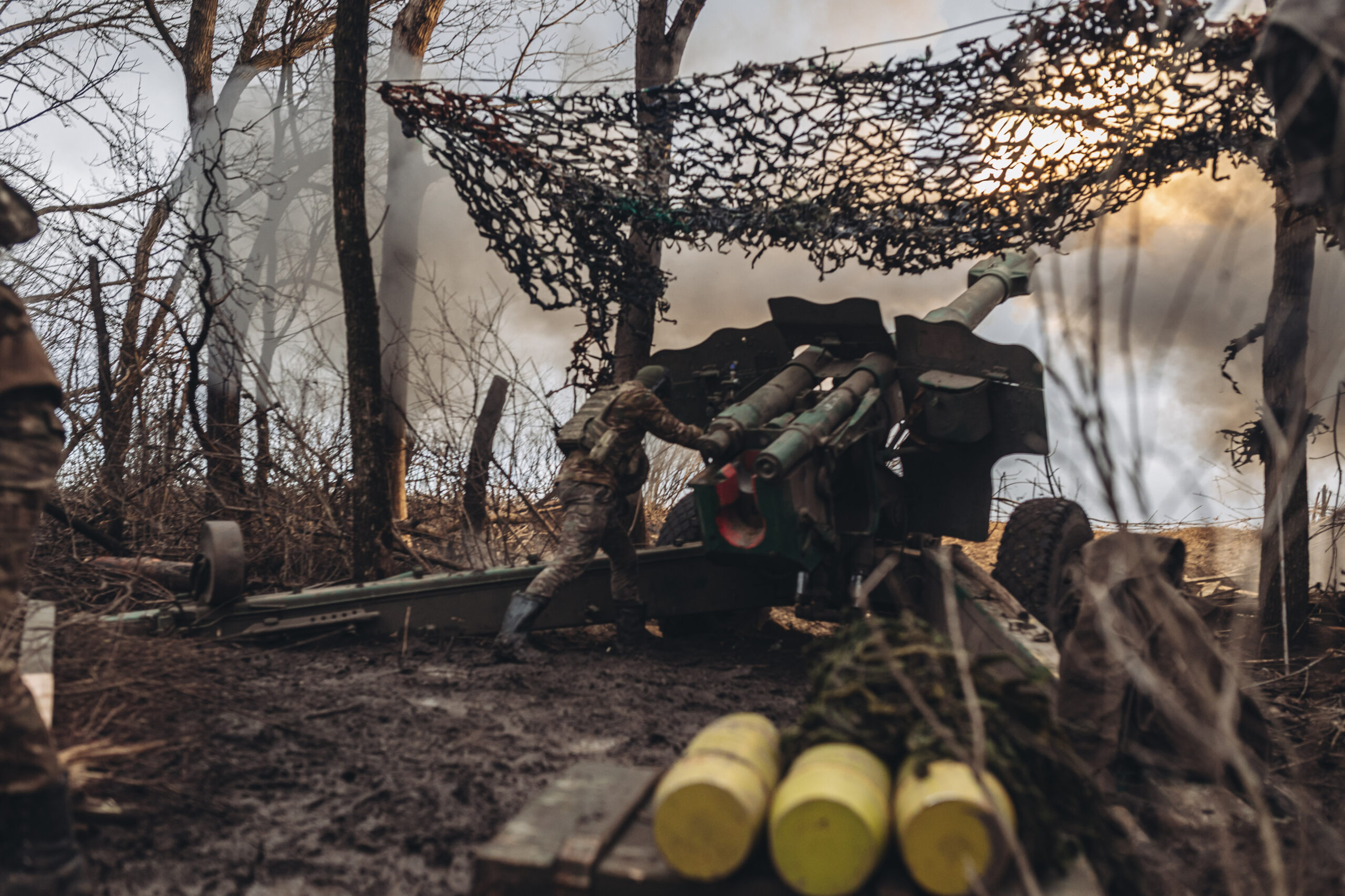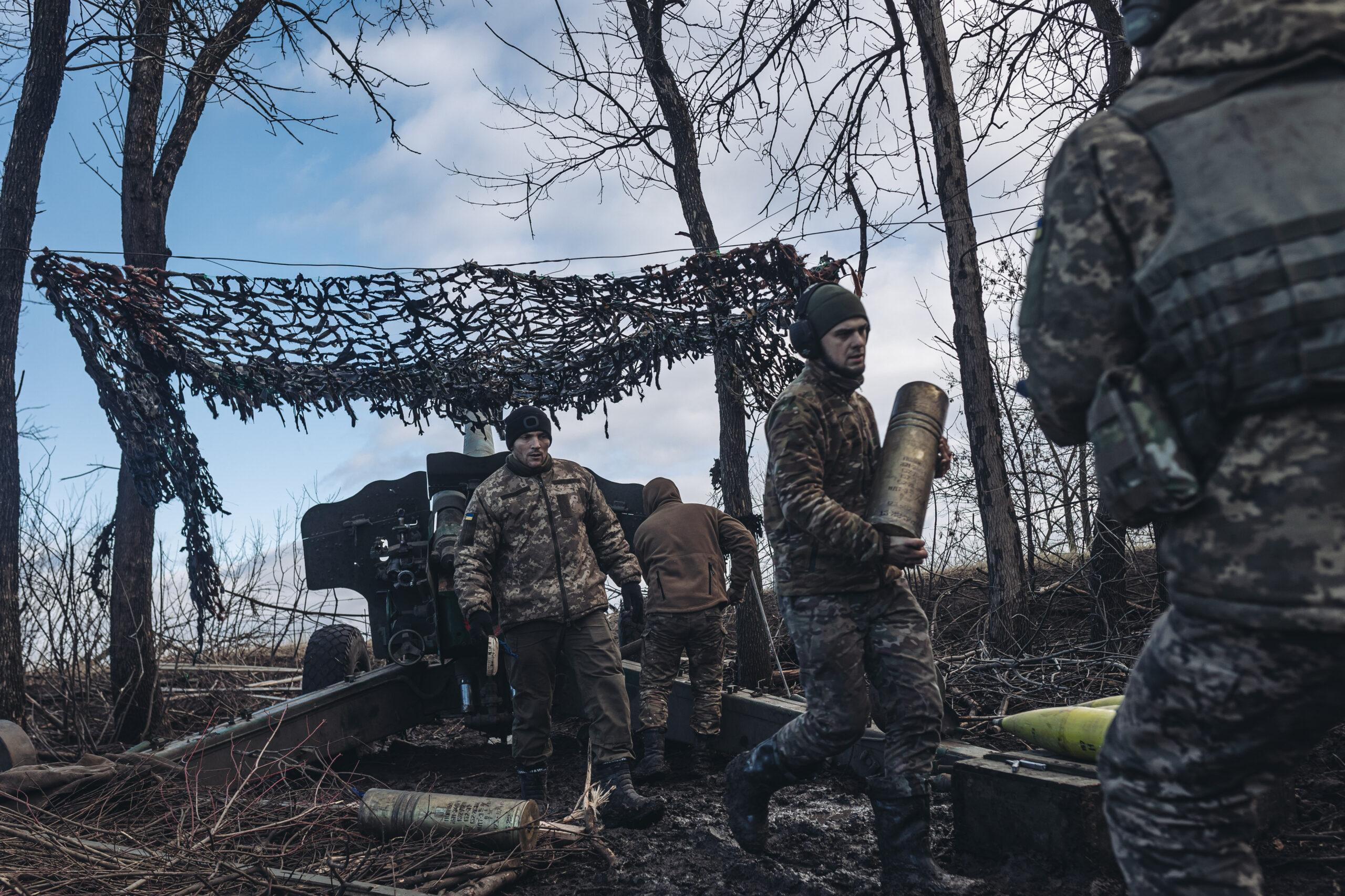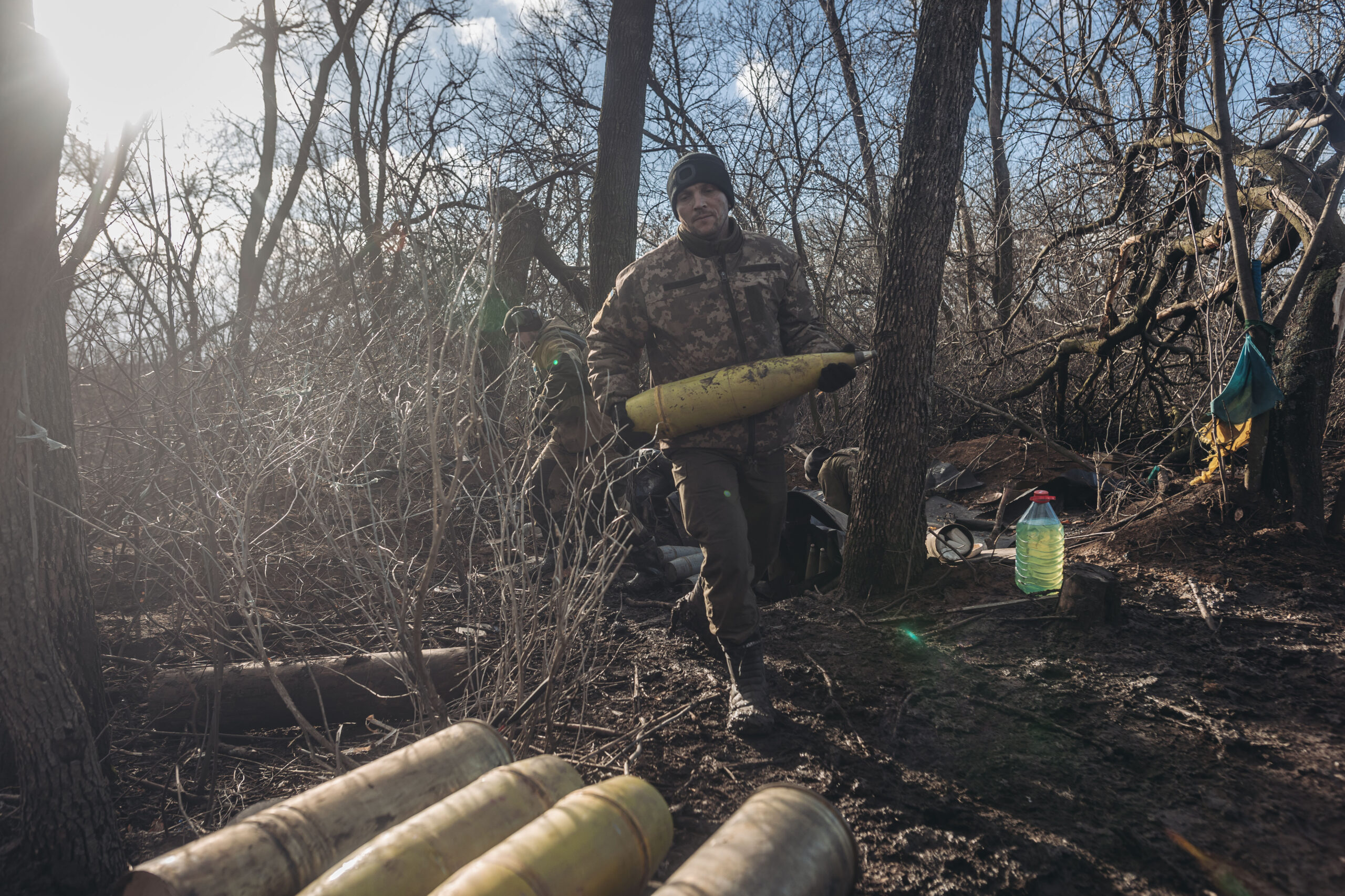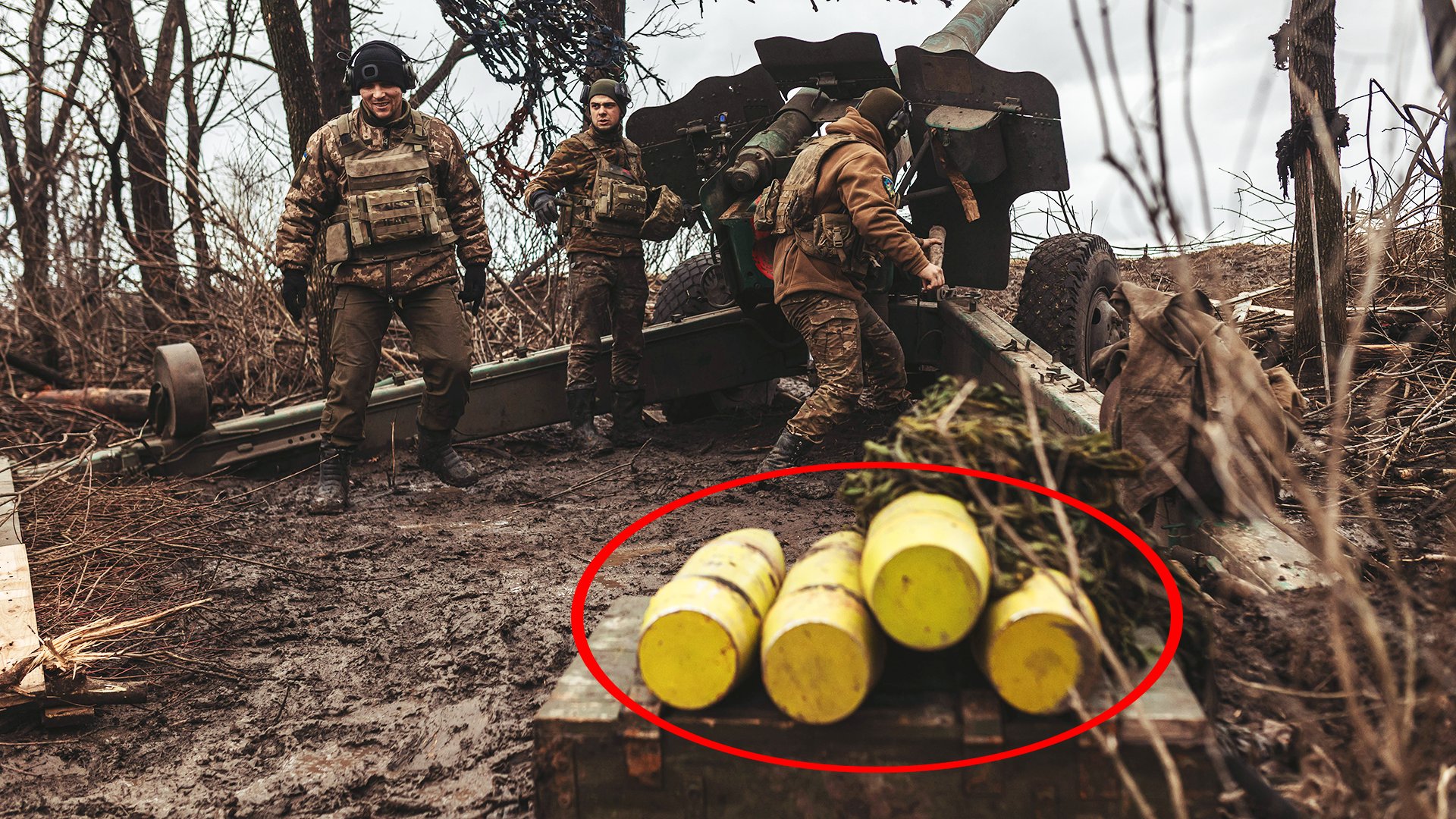Ukrainian-produced 152mm artillery shells filled with TNT have appeared on the front lines. The development speaks to how Ukraine’s defense enterprise has managed to remain functional after being subjected to nearly a full year of war and to an increasing artillery shortage that looms not just over Ukraine, but Russia too. Still, the scale at which they can continue producing these shells amid what has become a heavy artillery slug-fest is unclear.
Images of the locally-produced artillery began emerging on social media on January 1, 2023, but some of the photos themselves were taken the month prior and showed Ukrainian forces on the front lines in Donbas using bright yellow shells inscribed with dates indicating they had been made last year. The shells have since been identified as being OF-25T types modeled after Soviet-era OF-25 152mm high-explosive projectiles.
In a post on Twitter, the Ukraine Weapons Tracker open source intelligence account noted that there are slight differences in the index of the projectiles when compared to the classic Soviet OF-25 152mm shell, but chalked that up to likely being an effect of the manufacturing process. This heritage would make it so the shells could be fired from various Soviet-designed howitzers in Ukrainian service, including D-20 and 2A65 Msta-B towed howitzers and 2S3 Akatsiya and 2S19 Msta-S self-propelled howitzer types. A D-20 can actually be seen in one of the photos now circulating pictured next to a stack of the yellow munitions.
Both the original Soviet OF-25 projectiles and the new Ukrainian OF-25T shells look largely similar on the outside, being that each is assembled using several different ‘turned’ parts. Turning is a type of precision machining that rotates the workpiece against a cutting tool, and the technique used helped greatly with the identification process.
However, what’s on the inside of these projectiles differs. The Ukrainian OF-25T shells are filled with TNT, which can be noted by the Cyrillic ‘THT’ acronym seen written on the casing, as opposed to the A-IX-2 explosive material that is used inside Soviet OF-25 shells.

A-IX-2, sometimes referred to as Hexal, has been in use with the Russian military since World War II. The explosive is made up predominantly of the organic compound RDX but also consists of aluminum powder that has been desensitized by wax.
It’s worth mentioning at this point that a lot of modern western artillery shell production has shifted away from TNT to safer explosives with less sensitivity. For example, because of TNT’s propensity to explode if dropped or exposed to certain levels of combustion, the U.S. Army in 2010 qualified a new explosive formula called Insensitive Munitions Explosive 101, or IMX-101, as a safer alternative to the service’s existing TNT charged large-caliber projectiles.
While the TNT being used in the Ukrainian OF-25T shells would be less powerful than the A-IX-2 its Russian counterparts use, the explosive is nonetheless cheaper and easier to manufacture. This would have very likely played a significant role in Ukraine’s decision to use it for the production of these munitions.
The fact that Ukraine is domestically producing these OF-25T shells only underscores what has become a mad scramble on the parts of Russia as well as Ukraine and its allies to maintain a steady supply of artillery shells in the face of what has become largely an artillery slug-fest. While these numbers could very well have changed in the past couple of months, NBC reported in November that a senior U.S. defense official estimates that Ukraine is firing anywhere between 4,000 and 7,000 artillery rounds a day, with Russia firing a bewildering 20,000. Both countries are acutely aware of the consequences that falling behind because of insufficient artillery shell stocks would bring, as doing so would provide the other side with a massive battlefield advantage.
As Russia realigned its early strategy amid battlefield losses and the invasion became focused on the east of Ukraine, where artillery could more easily be brought to bear, Ukraine’s Deputy Head of Military Intelligence, Vadym Skibitsky, stated that the conflict with Russia has become “an artillery war that we are losing, [as] Ukraine has one artillery piece to 10-15 Russian artillery pieces and we have almost used up all of our ammunition.” Since then, the U.S. and its allies have poured massive amounts of artillery capabilities into Ukraine’s eclectic arsenal.
The United States has donated far more than one million rounds alone. Russia itself is also now grappling with the dwindling of its own stocks after many attacks on its ammunition depots and nearly a year of constant barrages across the battlefield, which has been highlighted by the country’s covert procurement of North Korean artillery shells.

Overseeing the local production of these shells is now known to be the state-owned and Kyiv-based arms industry conglomerate Ukroboronprom. According to Ukraine Weapons Tracker, Ukroboronprom’s own Telegram account has also since confirmed the claims that Ukraine is producing its own shells on the social media site.
Additionally, an article published by local Ukrainian news outlet Militarnyi in November 2022 detailed that Ukroboronprom had established the production of its own 122mm and 152mm shells for its Soviet-era artillery systems. The conglomerate said that the munitions have been tested and manufactured using “NATO technology” at production centers that are dispersed across multiple undisclosed locations both in Ukraine and in partner nations, which would line up with reports published at around the same time that spoke to how NATO had begun developing a 10-year plan to help rebuild Ukraine’s defense industry.
“Ukroboronprom-made ammunition will reduce the reliance of Ukraine’s artillery on supplies from abroad, as the global supply of Soviet-era shells is gradually dwindling,” Ukroboronprom was quoted as saying in a separate article about the artillery shell production.
According to an official statement made by Ukroboronprom itself in December of last year, the official domestic production of the 152mm artillery shells that have emerged on the front lines began two months earlier in October following a rather rocky battle to begin doing so that dates back to 2018. The statement explained how during that year, one of Ukroboronprom’s enterprises was successful in producing about four dozen cases of 152mm shells, but the effort was halted abruptly after Ukraine’s Ministry of Defense began ordering the munitions from a private contractor instead.
Those shells ended up being of inadequate quality, said Ukroboronprom. A lesser-known American company called Gray Fox Aviation and Logistics, which Ukroboronprom said had never even produced the desired munitions, was then selected and paid an advance of over $8 million by Kyiv to provide Ukraine’s Artem plant based in the same city with the tools needed to produce the artillery shells. The order failed to ever arrive and an international trial led by the Stockholm arbitration court later found that the company was fraudulent. Now, it would seem that Ukroboronprom is once again in charge of the production and has also been reloading previously fired cases with new propellant charges.

“Two months ago, for the first time in the years of independence, Ukraine began to mass-produce artillery ammunition of 152 mm caliber,” read the December 2022 Ukroboronprom statement. “Unfortunately, the war dictated new rules, so the production of projectiles is completely dispersed over a large number of cities in order to make it impossible for the enemy to cover our employees with rockets.”
Regardless, Ukraine’s artillery shell shortage persists and any working projectiles the country’s forces can get their hands on are likely a welcome addition. This reality was especially underscored by recent evidence that 155mm shells from Pakistan may have made their way to Ukraine along with propellant charges, which are equally as important as they allow for the firing of said shells. Ukraine Weapons Tracker noted that the source of the ammunition was likely a Western backer of Ukraine that purchased the Pakistani shells and delivered them as a third party.
A similar development from October that can be read about in detail in this past War Zone feature cited evidence that Pakistan had been delivering 122mm HOW HE-D30 artillery shells manufactured by the Pakistan Ordnance Factories to Ukraine via facilitation by the United Kingdom. While the types noted in the tweet above are 155mm, the photos still confirm that the unlikely connection between Ukraine and Pakistan, enabled by Ukraine’s NATO allies, exists in some capacity borne from the need for more firepower.
The type of shells Ukraine has been receiving from Pakistan also emphasizes the fact that a growing variety of artillery systems are in use with Ukrainian forces that each require their own respective rounds. While the United States and its allies have worked to westernize Ukraine’s artillery systems, with huge numbers of shells being donated to the cause and shipped to Ukraine, questions still exist as to how long such support can remain at current levels. Legacy Soviet-designed artillery systems also offer diversification, which is important considering the pinch of ammunition.

Essentially, Ukraine’s newly established local production of these artillery shells is just one part of a cocktail of solutions that are needed to keep its war machine competing with Russia’s. However, with Soviet-type shells diminishing and Russia scrambling to feed its own needs, too, having the ability to produce locally is more important than ever.
Despite the widespread and near-constant military aid that has been flowing into Ukraine since the conflict began almost a year ago, the relentless shelling that has become a staple for both sides will continue to devour ammunition. While efforts like that of Ukroboronprom’s aim to quickly answer the demand for more shells in a sustainable way, it isn’t clear just how much of a dent it can make in this looming problem. Doing so in a war zone, where manufacturing facilities and storage centers for shells would be top targets for Russia, also has its challenges and risks. But the fact that Ukraine has been able to stand-up artillery shell production at all is a testament to its ingenuity and ability to move forward under what are incredibly challenging circumstances.
Contact the author: Emma@thewarzone.com
